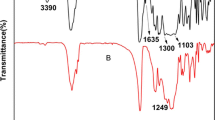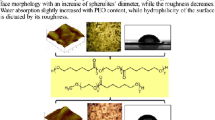Summaries
Blends of poly(ε-caprolactone)-poly(fluoroalkylene oxide)-poly(ε-caprolactone) (PCL-PFPE-PCL) triblock copolymers (with different length of PFPE and PCL segments) and poly(vinyl chloride) (PVC) were prepared by casting from tetrahydrofuran solution. DSC analysis revealed a complex morphology deriving from miscibility between PCL and PVC segments. XPS analysis showed strong surface enrichment of PFPE segments for all films prepared. Treatment with a PFPE selective solvent showed that the fraction of PCL-PFPE-PCL removed from surface decreased with increasing length of PCL blocks, indicating an anchorage effect by PCL segments with respect to PVC matrix.
Résumé
Des mélanges de tribloc polymères, poly(caprolactone-b-perfluoropolyéther-b-caprolactone) (PCL-PFPE-PCL) (les segments PFPE ayant une longeur différente de celle des segments PCL) et de poly(chlorure de vinyle) (PVC) ont été préparées par moulage [“casting”] à partir d’une solution de tetrahydrofuran. Une analyse par DSC a révélé une morphologie complexe provenant de la miscibilité entre les segments PCL et PVC. Une analyse XPS a révélé un fort enrichissement de la surface par des segments PFPE dans le cas de tous les feuils préparés. Le traitement par solvant sélectif (PFPE) a démontré que la quantité de PCL-PFPE-PCL enlevé de la surface diminuait au fur et à mesure que la longeur des blocs PCL augmentait, ce qui indiquait qu’il y avait un effet d’ancrage par les segments PCL vis à vis de la matrice PVC.
Zusammenfassung
Mischungen von Poly (Caprolacton-b-Perfluoropolyether-b-Caprolacton) (PCL-PFPE-PCL) Dreiblockcopolymere mit unterschiedlichen Längen der PFPE und PCL Segmente und PVC wurden mittlels einer Tetrahydrofuran-Lösung hergestellt.
Eine DSC Analyse zeigte eine komplexe Morphologie, die sich aus der Mischbarkeit der PCL und PFPE-Segmente ergibt. Eine XPS-Analyse wies darüberhinaus auf, daß sich die Oberfläche aller hergestellten Filme stark mit PFPE angereichert hatte. Die Behandlung mit einem PFPE-spezifischen Lösungsmittel zeigte, daß der Anteil der PCL-PFPE-PCL-Moleküle, der von der Oberfläche entternt wurde, mit zunehmender Länger der PCL-Segmente abnahm. Dies weist darauf hin, das die PCL-Segmente bezüglich der PVC-Matrix einen Ankereffekt haben.
Similar content being viewed by others
References
Marchionni G, G Ajroldi and G Pezzin, ‘Structure-property relationships in perfluoropolyethers: A family of polymeric oils, Comprehensive Polymer Science, 347–88, G Allen (ed), 2nd supplement, Pergamon Press, Oxford, 1996
Hardman B and A Torkelson, ‘Silicones’, Encyclopedia of Polymer Science and Engineering, H Mark (ed), 15, 204–308, Wiley-Interscience, New York
Tonelli C, P Gavezzotti and E Strepparola, ‘Linear períluoropolyether difunctional oligomers: Chemistry, properties and applications’,Journal of Fluorine Chemistry,95, 51–70, 1999
Krause S, ‘Polymer-polymer compatibility’, Polymer Blends, Chapter 3, D R Paul and S Newman (eds), Academic Press, New York, 1978
Toselli M, F Pilati, C Tonelli, M Messori, A Priola, R Bongiovanni, G Malucelli and C Tonelli, ‘Poly(ε-caprolactone)-poly(fluoroalkylene oxide)-poly(ε-caprolactone) block copolymers: 1. Synthesis and molecular characterisation’,Macromolecules,32, 6969–76, 1999
Bottino F A, G Di Pasquale, A Pollicino, F Pilati, M Toselli and C Tonelli, ‘XPS study on surface segregation in poly(ethylene-iso terephthalate)-perfluoropolyether block-copolymers’,Macromolecules,31, 7814–9, 1998
Clark M B, C A Burkhardt and J A Gardella, ‘Surface studies of polymer blends. 3. An ESCA, IR, DSC study of poly(ε-caprolactone)/poly(vinyl chloride) homopolymer blends’,Macromolecules,22, 4495–501, 1989
Toselli M, M Messori, R Bongiovanni, G Malucelli, A Priola, F Pilati and C Tonelli, ‘Poly(ε-caprolactone)-poly(fluoroalkylene oxide)-poly(ε-caprolactone) block copolymers: 2. Thermal and surface properties’,Polymer,42, 1771–9, 2001
Author information
Authors and Affiliations
Corresponding author
Rights and permissions
About this article
Cite this article
Messori, M., Toselli, M., Pilati, F. et al. Poly(ε-caprolactone)-poly(fluoroalkylene oxide)-poly(ε-caprolactone) block copolymers as surface modifiers of poly(vinyl chloride). Surface Coatings International Part B: Coatings Transactions 85, 197–201 (2002). https://doi.org/10.1007/BF02699509
Issue Date:
DOI: https://doi.org/10.1007/BF02699509




